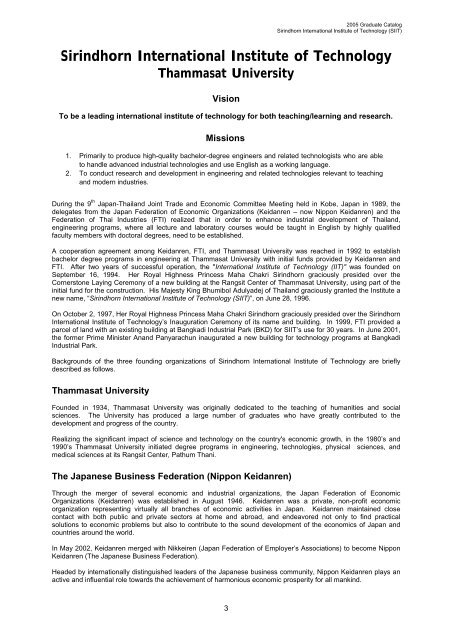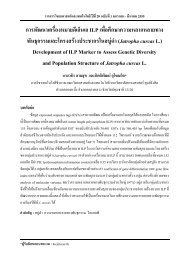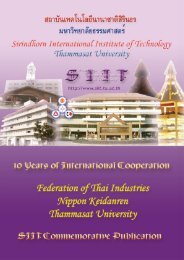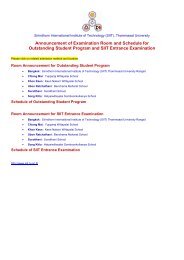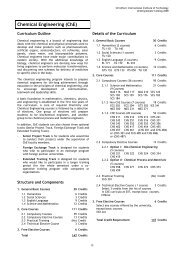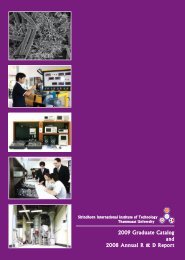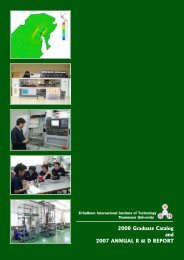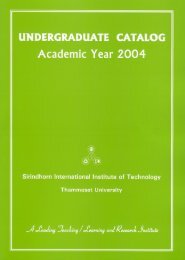2005 Graduate Catalog and 2004 Annual R & D Report - Sirindhorn ...
2005 Graduate Catalog and 2004 Annual R & D Report - Sirindhorn ...
2005 Graduate Catalog and 2004 Annual R & D Report - Sirindhorn ...
- No tags were found...
Create successful ePaper yourself
Turn your PDF publications into a flip-book with our unique Google optimized e-Paper software.
<strong>2005</strong> <strong>Graduate</strong> <strong>Catalog</strong><br />
<strong>Sirindhorn</strong> International Institute of Technology (SIIT)<br />
<strong>Sirindhorn</strong> International Institute of Technology<br />
Thammasat University<br />
Vision<br />
To be a leading international institute of technology for both teaching/learning <strong>and</strong> research.<br />
Missions<br />
1. Primarily to produce high-quality bachelor-degree engineers <strong>and</strong> related technologists who are able<br />
to h<strong>and</strong>le advanced industrial technologies <strong>and</strong> use English as a working language.<br />
2. To conduct research <strong>and</strong> development in engineering <strong>and</strong> related technologies relevant to teaching<br />
<strong>and</strong> modern industries.<br />
During the 9 th Japan-Thail<strong>and</strong> Joint Trade <strong>and</strong> Economic Committee Meeting held in Kobe, Japan in 1989, the<br />
delegates from the Japan Federation of Economic Organizations (Keidanren – now Nippon Keidanren) <strong>and</strong> the<br />
Federation of Thai Industries (FTI) realized that in order to enhance industrial development of Thail<strong>and</strong>,<br />
engineering programs, where all lecture <strong>and</strong> laboratory courses would be taught in English by highly qualified<br />
faculty members with doctoral degrees, need to be established.<br />
A cooperation agreement among Keidanren, FTI, <strong>and</strong> Thammasat University was reached in 1992 to establish<br />
bachelor degree programs in engineering at Thammasat University with initial funds provided by Keidanren <strong>and</strong><br />
FTI. After two years of successful operation, the "International Institute of Technology (IIT)" was founded on<br />
September 16, 1994. Her Royal Highness Princess Maha Chakri <strong>Sirindhorn</strong> graciously presided over the<br />
Cornerstone Laying Ceremony of a new building at the Rangsit Center of Thammasat University, using part of the<br />
initial fund for the construction. His Majesty King Bhumibol Adulyadej of Thail<strong>and</strong> graciously granted the Institute a<br />
new name, “<strong>Sirindhorn</strong> International Institute of Technology (SIIT)”, on June 28, 1996.<br />
On October 2, 1997, Her Royal Highness Princess Maha Chakri <strong>Sirindhorn</strong> graciously presided over the <strong>Sirindhorn</strong><br />
International Institute of Technology’s Inauguration Ceremony of its name <strong>and</strong> building. In 1999, FTI provided a<br />
parcel of l<strong>and</strong> with an existing building at Bangkadi Industrial Park (BKD) for SIIT’s use for 30 years. In June 2001,<br />
the former Prime Minister An<strong>and</strong> Panyarachun inaugurated a new building for technology programs at Bangkadi<br />
Industrial Park.<br />
Backgrounds of the three founding organizations of <strong>Sirindhorn</strong> International Institute of Technology are briefly<br />
described as follows.<br />
Thammasat University<br />
Founded in 1934, Thammasat University was originally dedicated to the teaching of humanities <strong>and</strong> social<br />
sciences. The University has produced a large number of graduates who have greatly contributed to the<br />
development <strong>and</strong> progress of the country.<br />
Realizing the significant impact of science <strong>and</strong> technology on the country's economic growth, in the 1980’s <strong>and</strong><br />
1990’s Thammasat University initiated degree programs in engineering, technologies, physical sciences, <strong>and</strong><br />
medical sciences at its Rangsit Center, Pathum Thani.<br />
The Japanese Business Federation (Nippon Keidanren)<br />
Through the merger of several economic <strong>and</strong> industrial organizations, the Japan Federation of Economic<br />
Organizations (Keidanren) was established in August 1946. Keidanren was a private, non-profit economic<br />
organization representing virtually all branches of economic activities in Japan. Keidanren maintained close<br />
contact with both public <strong>and</strong> private sectors at home <strong>and</strong> abroad, <strong>and</strong> endeavored not only to find practical<br />
solutions to economic problems but also to contribute to the sound development of the economics of Japan <strong>and</strong><br />
countries around the world.<br />
In May 2002, Keidanren merged with Nikkeiren (Japan Federation of Employer’s Associations) to become Nippon<br />
Keidanren (The Japanese Business Federation).<br />
Headed by internationally distinguished leaders of the Japanese business community, Nippon Keidanren plays an<br />
active <strong>and</strong> influential role towards the achievement of harmonious economic prosperity for all mankind.<br />
3


